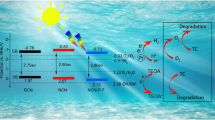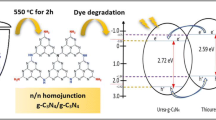Abstract
Herein, we report a detailed study on creating heterojunction between graphitic carbon nitride (g-C3N4) and bismuth phosphate (BiPO4), enhancing the unpaired free electron mobility. This leads to an accelerated photocatalysis of 2,4-dichlorophenols (2,4-DCPs) under sunlight irradiation. The heterojunction formation was efficaciously conducted via a modest thermal deposition technique. The function of g-C3N4 plays a significant role in generating free electrons under sunlight irradiation. Together, the generated electrons at the g-C3N4 conduction band (CB) are transferred and trapped by the BiPO4 to form active superoxide anion radicals (•O2−). These active radicals will be accountable for the photodegradation of 2,4-DCPs. The synthesized composite characteristics were methodically examined through several chemical and physical studies. Due to the inimitable features of both g-C3N4 and BiPO4, its heterojunction formation, 2.5wt% BiPO4/g-C3N4 achieved complete 2,4-DCP removal (100%) in 90 min under sunlight irradiation. This is due to the presence of g-C3N4 that enhanced electron mobility through the formation of heterojunctions that lengthens the electron-hole pairs’ lifetime and maximizes the entire solar spectrum absorption to generate active electrons at the g-C3N4 conduction band. Thus, this formation significantly draws the attention for future environmental remediation, especially in enhancing the entire solar spectrum’s harvesting.
Graphical abstract








Similar content being viewed by others
Data availability
All data generated or analysed during this study are included in this published article and its supplementary information files.
References
Ahsaine HA, El Jaouhari A, Slassi A, Ezahri M, Benlhachemi A, Bakiz B, Guinneton F, Gavarri J-R (2016a) Electronic band structure and visible-light photocatalytic activity of Bi2WO6: elucidating the effect of lutetium doping. RSC Adv 6:101105–101114. https://doi.org/10.1039/C6RA22669H
Ahsaine HA, Ezahri M, Benlhachemi A, Bakiz B, Villain S, Guinneton F, Gavarri J-R (2016b) Novel Lu-doped Bi2WO6 nanosheets: synthesis, growth mechanisms and enhanced photocatalytic activity under UV-light irradiation. Ceram Int 42:8552–8558. https://doi.org/10.1016/j.ceramint.2016.02.082
Ahsaine HA, Slassi A, Naciri Y, Chennah A, Jaramillo-paez C, Anfar Z, Zbair M, Benlhachemi A, Navio JA (2018) Photo/electrocatalytic properties of nanocrystalline ZnO and La-doped ZnO: combined DFT fundamental semiconducting properties and experimental study. ChemistrySelect 3:7778–7791. https://doi.org/10.1002/slct.201801729
Alcudia-Ramos MA, Fuentez-Torres MO, Ortiz-Chi F, Espinosa-Gonzalez CG, Hernandez-Como N, Garcia-Zaleta DS, Kesarla MK, Torres-Torres JG, Collins-Martinez V, Godavarthi S (2020) Fabrication of g-C3N4/TiO2 heterojunction composite for enhanced photocatalytic hydrogen production. Ceram Int 46:38–45. https://doi.org/10.1016/j.ceramint.2019.08.228
Gao C, Wei T, Zhang Y, Song X, Huan Y, Liu H, Zhao M, Yu J, Chen X (2019) A photoresponsive rutile TiO2 heterojunction with enhanced electron-hole separation for high performance hydrogen evolution. Adv Mater 31:1806596. https://doi.org/10.1002/adma.201806596
Guo F, Wang K, Lu J, Chen J, Dong X, Xia D, Zhang A, Wang A (2019) Activation of peroxymonosulfate by magnetic carbon supported Prussian blue nanocomposite for the degradation of organic contaminants with singlet oxygen and superoxide radicals. Chemosphere 218:1071–1081. https://doi.org/10.1016/j.chemosphere.2018.11.197
He K, Xie J, Liu ZQ, Li N, Chen X, Hu J, Li X (2018) Multi-functional Ni3C cocatalyst/g-C3N4 nanoheterojunctions for robust photocatalytic H2 evolution under visible light. J Mater Chem A 6:13110–13122. https://doi.org/10.1039/C8TA03048K
Jiao Y, Li Y, Wang J, He Z, Li Z (2020) Exfoliation-induced exposure of active sites for g-C3N4/N-doped carbon dots heterojunction to improve hydrogen evolution activity. Mol Catal 497:111223. https://doi.org/10.1016/j.mcat.2020.111223
Jin Z, Zhang Z, Xiu J, Song H, Gatti T, He Z (2020) A critical review on bismuth and antimony halide-based perovskites and their derivatives for photovoltaic applications: recent advances and challenges. J Mater Chem A 8:16166–16188. https://doi.org/10.1039/D0TA05433J
Jun D, Jiexiang X, Mengxia J, Bin W, Sheng Y, Qi Z, Zhigang C, Huaming L (2016) Advanced photocatalytic performance of graphene-like BN modified BiOBr flower-like materials for the removal of pollutants and mechanism insight. Appl Catal B 183:254–262. https://doi.org/10.1016/j.apcatb.2015.10.036
Jun D, Jiexiang X, Mengxia J, Hongping L, Hui X, Huaming L, Rong C (2015) The synergistic role of carbon quantum dots for the improved photocatalytic performances of Bi2MoO6. Nanoscale 7:11433–11443. https://doi.org/10.1039/c5nr01350j
Leong KH, Chu HY, Ibrahim S, Saravanan P (2015a) Palladium nanoparticles anchored to anatase TiO2 for enhanced surface plasmon resonance-stimulated, visible-light-driven photocatalytic activity. Beilstein J Nanotechnol 6:428–437. https://doi.org/10.3762/bjnano.6.43
Leong KH, Liu SL, Sim LC, Saravanan P, Jang M, Ibrahim S (2015b) Surface reconstruction of titania with g-C3N4 and Ag for promoting efficient electrons migration and enhanced visible light photocatalysis. Appl Surf Sci 358:370–376. https://doi.org/10.1016/j.apsusc.2015.06.184
Li M, Zhang G, Feng C, Wu H, Mei H (2020) Highly sensitive detection of chromium (VI) by photoelectrochemical sensor under visible light based on Bi SPR-promoted BiPO4/BiOI heterojunction. Sensors Actuators B Chem 305:127449. https://doi.org/10.1016/j.snb.2019.127449
Liu HY, Liang C, Niu CG, Huang DW, Du YB, Guo H, Zhang L, Yang YY, Zeng GM (2019) Facile assembly of g-C3N4/Ag2CO3/graphene oxide with a novel dual Z-scheme system for enhanced photocatalytic pollutant degradation. Appl Surf Sci 475:21–434. https://doi.org/10.1016/j.apsusc.2019.01.018
Liu J, Zhang T, Wang Z, Dawson G, Chen W (2011) Simple pyrolysis of urea into graphitic carbon nitride with recyclable adsorption and photocatalytic activity. J Mater Chem 21:14398–14401. https://doi.org/10.1039/C1JM12620B
Liu Y, Sun M, Liu Y, Chen G, Zhang X (2015) Effects of aging time on phase, morphology, and luminescence by two-photon processes of BiPO4:Er3+, Yb3+ in the solvothermal synthesis. Opt Mater 45:32–36. https://doi.org/10.1016/j.optmat.2015.03.004
Ma D, Zhong J, Li J, Burda C, Duan R (2019) Preparation and photocatalytic performance of MWCNTs/BiOCl: evidence for the superoxide radical participation in the degradation mechanism of phenol. Appl Surf Sci 480:395–403. https://doi.org/10.1016/j.apsusc.2019.02.195
Mohammadi M, Hadadzadeh H, Kaikhosravi M, Farronkhpour H, Shakeri J (2020) Selective photocatalytic oxidation of benzyl alcohol at ambient conditions using spray-dried g-C3N4/TiO2 granule. Mol Catal 490:110927. https://doi.org/10.1016/j.mcat.2020.110927
Munikrishnappa C, Kumar S, Shivakumara S, Mohan Rao G, Munichandraiah N (2019) The TiO2-graphene oxide-hemin ternary hybrid composite material as an efficient heterogeneous catalyst for the degradation of organic contaminants. J Sci-Adv Mater Dev 4:80–88. https://doi.org/10.1016/j.jsamd.2018.12.003
Ni Z, Dong F, Huang H, Zhang Y (2016) New insights into how Pd nanoparticles influence the photocatalytic oxidation and reduction ability of g-C3N4 nanosheets. Catal Sci Technol 6:6448–6458. https://doi.org/10.1039/C6CY00580B
Ong WJ, Tan LL, Ng YH, Yong ST, Chai SP (2016) Graphitic carbon nitride (g-C3N4) based photocatalysts for artificial photosynthesis and environmental remediation: are we a step closer to achieving sustainability? Chem Rev 116:7159–7329. https://doi.org/10.1021/acs.chemrev.6b00075
Qian R, Zong H, Schneider J, Zhou G, Zhao T, Li Y, Yang J, Bahnemann DW, Pan JH (2019) Charge carrier trapping, recombination and transfer during TiO2 photocatalysis: an overview. Catal Today 335:78–90. https://doi.org/10.1016/j.cattod.2018.10.053
Romero B, Bruque S, Aranda MAG, Iglesias JE (1994) Synthesis, crystal structures, and characterization of bismuth phosphate. Inorg Chem 33:1869–1874. https://doi.org/10.1021/ic00087a023
Sim LC, Koh LS, Leong KH, Chin YH, Aziz AA, Saravanan P (2020) In situ growth of g-C3N4 on TiO2 nanotube arrays: construction of heterostructures for improved photocatalysis properties. J Environ Chem Eng 8(1):103611. https://doi.org/10.1016/j.jece.2019.103611
Singh J, Basu S (2020) Synthesis of mesoporous magnetic Fe2O3/g-C3N4 monoliths for rhodamine B removal. Microporous Mesoporous Mater 303:110299. https://doi.org/10.1016/j.micromeso.2020.110299
Wang Y, Jiang W, Luo W, Chen X, Zhu Y (2018) Ultrathin nanosheets g-C3N4@Bi2WO6 core-shell structure via low temperature reassembled strategy to promote photocatalytic activity. Appl Catal B-Environ 237:633–640. https://doi.org/10.1016/j.apcatb.2018.06.013
Wang Z, Jiang L, Wang K, Li Y, Zhang G (2021) Novel AgI/BiSbO4 heterojunction for efficient photocatalytic degradation of organic pollutants under visible light: interfacial electron transfer pathway DFT calculation and degradation mechanism study. J Hazard Mater 410:124948. https://doi.org/10.1016/j.jhazmat.2020.124948
Xia J, Zhao J, Chen J, Di J, Ji M, Xu L, Chen Z, Li H (2017) Facile fabrication of g-C3N4/BiPO4 hybrid materials via a reactable ionic liquid for the photocatalytic degradation of antibiotic ciprofloxacin. J Photochem Photobiol A Chem 339:59–66. https://doi.org/10.1016/j.jphotochem.2017.02.010
Xu J, Li L, Guo C, Zhang Y, Meng W (2013) Photocatalytic degradation of carbamazepine by tailored BiPO4: efficiency, intermediates and pathway. Appl Catal B 130:285–292. https://doi.org/10.1016/j.apcatb.2012.11.013
Zhang M, Hou Z, Ma W, Zhao X, Ma C, Zhu Z, Yan Y, Li C (2018) Fabrication of a visible-light In2S3/BiPO4 heterojunction with enhanced photocatalytic activity. New J Chem 42:15136–15145. https://doi.org/10.1039/C8NJ03284J
Zhang Y, Selvaraj R, Sillanpaa M, Kim Y, Tai C-W (2014) The influence of operating parameters on heterogeneous photocatalytic mineralization of phenol over BiPO4. Chem Eng J 245:117–123. https://doi.org/10.1016/j.cej.2014.02.028
Zhao H, Fan T, Wang R, Chen R (2014) A review on bismuth-related nanomaterials for photocatalysis. Rev Adv Sci Eng 3(1):3–27. https://doi.org/10.1166/rase.2014.1050
Zhao X, Wang X, Sun Z, Li Z, Sun D (2020) Efficient visible-light photocatalytic performance of CdS/BiPO4 nanoparticles fabricated by solvothermal method. Optik 208:164543. https://doi.org/10.1016/j.ijleo.2020.164543
Zheng Y, Zhang Z, Li C (2017) A comparison of graphitic carbon nitrides synthesized from different precursors through pyrolysis. J Photochem Photobiol A Chem 332:32–44. https://doi.org/10.1016/j.jphotochem.2016.08.005
Funding
This research was financed by Universiti Tunku Abdul Rahman Research Fund, UTARRF (IPSR/RMC/UTARRF/2018-C2/L03), and Ministry of Higher Education of Malaysia, Fundamental Research Grant Scheme, FRGS (FRGS/1/2019/TK10/UTAR/02/5).
Author information
Authors and Affiliations
Contributions
Review, methodology, investigation, and writing of original draft: Jit Jang Ng. Resources, methodology, funding acquisition, supervision: Lan Ching Sim. Methodology, resources: Wen-Da Oh. Visualization, validation: Pichiah Saravanan. Visualization, validation: Bo Tan. Supervision, review and editing of original manuscript, funding acquisition, conceptualization, visualization, validation: Kah Hon Leong.
Corresponding author
Ethics declarations
Ethics approval and consent to participate
Not applicable
Consent for publication
Not applicable
Competing interests
The authors declare no competing interests.
Additional information
Responsible Editor: Sami Rtimi
Publisher’s note
Springer Nature remains neutral with regard to jurisdictional claims in published maps and institutional affiliations.
Rights and permissions
Springer Nature or its licensor (e.g. a society or other partner) holds exclusive rights to this article under a publishing agreement with the author(s) or other rightsholder(s); author self-archiving of the accepted manuscript version of this article is solely governed by the terms of such publishing agreement and applicable law.
About this article
Cite this article
Ng, J.J., Sim, L.C., Oh, WD. et al. Accelerated sunlight photocatalysis through improved electron mobility between g-C3N4 and BiPO4 nanomaterial. Environ Sci Pollut Res 29, 86068–86076 (2022). https://doi.org/10.1007/s11356-021-16449-y
Received:
Accepted:
Published:
Issue Date:
DOI: https://doi.org/10.1007/s11356-021-16449-y




